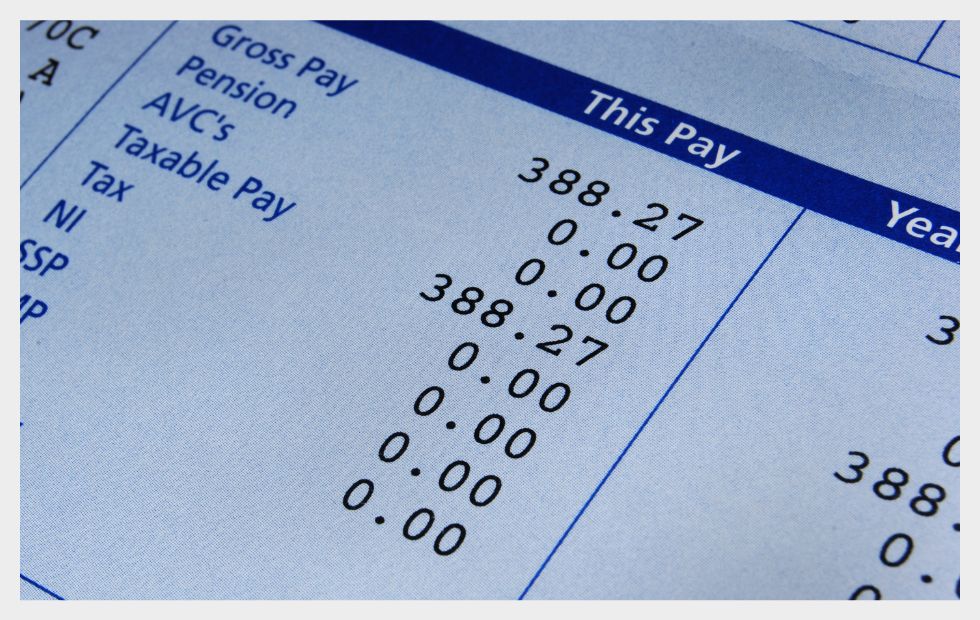How do U.S. paychecks work?

Breaking Down a U.S. Paycheck: Gross pay, deductions, and net income explained.
When you first see your paycheck, it can be a bit overwhelming. But if you take the time to learn how paychecks work, each part will make sense.
On your first paycheck, you will see a dollar amount called “gross pay,” which is the money you earned before any deductions were removed. After this, you may notice a dollar amount called “net income,” which can also be called your “take-home pay.” As the name suggests, this is the money you can keep for yourself.
You might ask yourself, “What’s the difference between gross pay and net pay?” or “What is a deduction?” These questions are normal, especially if you’re just beginning your journey in the United States workforce.
Whether you receive your paycheck in paper form or as an electronic deposit, it will also include a section known as a “pay stub.” When you look at your pay stub, you’ll see multiple sections with titles like “earnings,” “gross pay,” and “net income,” and then another section called “deductions,” with subsections such as “federal income tax,” “social security tax,” and “Medicare.”
While these terms may seem confusing, the different parts of your paycheck will make sense after you learn what they mean. In this article, we’ll examine the most common parts of the U.S. paycheck.
In this guide, we will answer the following questions:
- What is gross income?
- What is additional compensation?
- What are deductions?
- Are there other deductions from my paycheck?
- What is net pay?
- How do pay periods and pay dates work?
- How do paychecks work for non-citizen workers?
What is gross income?
When you hear The term “gross income,” it could have two possible meanings.
The first meaning refers to the total earnings an individual receives from any source of income in their life. These sources of income could mean any money related to work or money someone might receive from a rental property, pension funds, investments and more.
The second meaning of “gross income” is one you might hear in casual conversation at work. In this situation, people are probably talking about the money they earn specifically from their job before deductions for tax or healthcare are taken out of their paycheck.

Gross income is the total earnings before taxes and deductions, including salary, bonuses, and other compensation.
Here, we will talk specifically about gross income as it is related to your paycheck from work. Generally, there are two different methods used to determine how much money employees will receive: salary and hourly.
What is hourly payment?
Determining an hourly wage is a common method used by companies and organizations to compensate employees for their work. This hourly rate is usually decided before someone begins a new job and that rate is written in an employment contract.
This means that each hour an employee works, they are given a predetermined amount of money. So, if an employee earns $20 each hour and works eight hours in one day, their gross income for the day would be $160. If that employee worked a normal 40-hour workweek, their gross income will be $800.
It’s important to note that each state requires employers to pay at least a minimum amount of money per hour, which is known as the “minimum wage.”
What is minimum wage?
Minimum wage is the lowest hourly wage rate that employers are legally required to pay their employees by federal or state law. The federal minimum wage, currently set at $7.25 per hour, serves as the baseline standard across the United States.
After that, each state has the authority to choose to set a higher minimum wage if they deem it necessary to better suit their local economic conditions and standards of living.
For instance, New York State has set its minimum wage at $15 an hour, reflecting its higher cost of living and economic circumstances. In contrast, Florida has a minimum wage of $12 an hour, which reflects its relatively lower cost of living.
What is salaried payment?
As you’re looking for a new job, you may be offered a salary-based compensation structure rather than hourly pay. You’re more likely to be offered a salary by corporate companies, non-profit organizations, healthcare organizations, and government agencies.
With salaried positions, employees are usually expected to complete their work no matter how many hours they work. This might seem strange because there may be times when an employee works more than 40 hours but makes the same amount of money. However, salaried positions often offer extra stability through benefits like paid time off, health insurance, and retirement benefits.
A salary represents a predetermined and fixed amount of compensation that an employee receives from their employer over the course of a year in exchange for their services. While this compensation is typically distributed on a regular basis, such as monthly or biweekly, it’s often stated and discussed in terms of an annual sum. For instance, an individual might be offered a salary of $70,000 per year.
The specific amount of salary a person earns is usually influenced by various factors including the employer’s policies, the employee’s level of experience and expertise, common industry standards, and the cost of living in a specific geographic location.
What is additional compensation?
Sometimes there are additions to the base level of pay that a person receives from work.The most common additions to base pay include overtime pay, bonuses, and commissions. These additions are designed to compensate employees for exceptional circumstances, performance, or to provide incentives for achieving specific goals.

Additional Compensation: Extra pay for overtime, bonuses, and incentives.
What is overtime pay?
Overtime pay is additional compensation for any hours an employee works beyond the standard workweek. In the United States, a typical workweek is typically defined as 40 hours. The Fair Labor Standards Act (FLSA) in the United States mandates that people who are eligible for overtime should receive at least one and a half times their regular hourly rate for overtime hours.
For example, if an employee’s regular hourly rate is $20, their overtime rate would be $30 per hour. This is calculated by adding one and a half times the regular rate, which is $20 plus an additional $10, as $10 is half of $20. Therefore, the total overtime rate is $30. If an employee has already worked 40 hours in one week and begins working 41 or more hours, they will receive $30 per hour for each additional hour over 40.
Overtime is designed to compensate employees for extended work periods, acknowledging the extra effort and time spent beyond normal working hours.
What is a bonus?
Bonuses are additional pay given to employees as a reward for their performance, contribution to achieving company goals, or for special occasions.
One common type of bonus is a retention bonus, which encourages employees to stay with a company for a specified amount of time. Alternatively, bonuses may be tied to specific performance metrics or goals established by the employer. These reward employees for achieving targets such as sales quotas, project milestones, or customer satisfaction ratings.
You may also hear of year-end bonuses, which are typically awarded to employees as the calendar or fiscal year draws to a close. These bonuses are often influenced by factors like company and individual performance, as well as length of service.
Unlike overtime pay, bonuses are not part of the pay structure that the government oversees. Instead, bonuses are a tool used to encourage and reward employees for their contributions to the company’s success.
What is a commission?
Commissions are a form of incentive pay tied to the sales or performance of an employee. This is a common practice in sales-oriented roles where employees receive a percentage of the sales they generate as part of their compensation.
For example, a salesperson might earn a 5% commission on all sales they close. To illustrate, if a salesperson sells a luxury refrigerator priced at $2,000, they will earn a $100 commission from this single sale, calculated as 5% of the sale price. Some common examples of careers that use commission as part of their pay structure are real estate agents, car salespeople, and financial advisors.
Commission structures can vary widely, from fixed rates to sliding scales based on performance levels. Commissions motivate employees to perform at higher levels by directly linking compensation to their success in generating revenue or achieving specific targets.
What are deductions?
In the context of a paycheck, deductions mean the money taken out before you receive your pay. These deductions are usually for things like taxes, insurance, retirement contributions, or public healthcare programs. Deductions are subtracted from your gross pay and the amount leftover is net pay.

Understanding Paycheck Deductions: Taxes, insurance, and other withholdings.
Let’s look at some of the most common deductions in the U.S.
What is federal income tax?
Federal income tax is a percentage of an individual’s earnings mandated by the federal government, with the specific amount determined by the employee’s income level and tax bracket.
In the United States, income tax operates on a progressive system, meaning that different portions of income are taxed at different rates within specified income ranges, known as tax brackets.
Let’s take the example of a single person with no dependents who made $70,000 in the year of 2023. If that person accepted the U.S. government’s standard deduction of $12,550, they would only be taxed on the remaining $57,450 of their income.
| Tax Bracket | Income Within Bracket | Income Multiplied by Percentage | Total |
| 10% | $0 to $11,000 | $11,000 x 10% | $1,100 |
| 12% | $11,001 to $44,725 | $33,724 x 12% | $4,047 |
| 22% | $44,726 to $95,375 | $12,725 x 22% | $2,799 |
| Final Total: $7,946 |
So, someone who makes a salary of $70,000 in one year, can expect to pay between $7,000 and $8,000 in federal taxes.
What is state income tax?
State income tax is money that people pay to their state government based on the money they earn. Each state sets its own rules and rates for how much tax people owe. Some states have no state income tax like Florida, Texas, and Washington.
When you work and earn money in a state, a portion of that money goes to the state government as tax. The amount of tax you owe depends on how much money you make and the rules in your state.
What is Social Security?
Another deduction you’ll see on your pay stub is Social Security which is a social program created by FICA (Federal Insurance Contributions Act).
Each pay period, employees have 6.2% of their gross income withheld for Social Security. This deduction is part of the government’s program to fund future benefits like retirement, disability, and survivorship support. The amount of income subject to this tax is capped annually, meaning there’s a maximum limit to how much can be taxed for Social Security purposes each year.
What is Medicare?
Medicare, as part of the deductions from paychecks under the FICA taxes, represents a health insurance program primarily for individuals aged 65 and older but also for some younger people with disabilities.
On paystubs, employees contribute 1.45% of their gross income to Medicare, with no cap on the amount of income that can be taxed. This contribution helps fund the costs of the Medicare program, ensuring that it can provide medical benefits to eligible beneficiaries.
Are there other deductions from my paycheck?
In addition to the mandatory deductions that might be taken by the state and government, there are sometimes optional deductions from your gross pay. The most common types of optional deductions you’ll see in the United States are for health insurance premiums, retirement plan contributions, and union dues.

Where Does Your Paycheck Go? Exploring optional deductions such as 401(k), Roth IRA, and union dues.
What are health insurance premiums?
Many employers offer health insurance to their employees as part of their benefits package.
This insurance helps cover the costs of medical care, like doctor visits and prescription medications. When you sign up for health insurance through your job, you might have to pay part of the cost, which is called a premium.
Your employer might take this premium out of your paycheck before you get paid. How much they take out can depend on the type of health insurance you choose and how much your employer decides to contribute toward the cost. So when you look at your paystub, you’ll probably see something like “health insurance.” Your paystub may even include the name of the healthcare provider, like “Mayo Health”, or “Kaiser Permanente.”
Usually, you’ll have the option to choose between a range of healthcare plans. The more expensive healthcare plans will pay for more expensive health problems, while the less expensive plans will cover fewer problems. Depending on which plan you choose, you can expect to pay between $100 and $500 each month.
How are retirement contributions taken out of my paycheck?
There are 3 main types of retirement accounts in the U.S.; 401(k), Roth IRA, and 403(b). These accounts help people save money for their future after they stop working. Each account is taxed a little differently.
-
What is a 401(k)?
This is offered by many employers and allows employees to save money from their paychecks before taxes are taken out. This means that the money you put into a 401(k) isn’t taxed right away, which can lower your taxable income for the year. However, when you take the money out of your 401(k) during retirement, you’ll have to pay taxes on it based on your income tax rate at that time. It might be labeled as “401(k) deduction” or something similar on your paystub.
-
What is a 403(b)?
This is similar to a 401(k), but it’s usually offered by certain employers like public schools, hospitals, and non-profit organizations. With a 403(b), you can also save money from your paycheck before taxes are taken out, just like with a 401(k). It might be labeled as “403(b) contribution” or something similar on your paystub.
-
What is a Roth IRA?
This is an individual retirement account that you open on your own with a financial institution. With a Roth IRA, you contribute money that has already been taxed from your paycheck and you won’t see it on your paystub.
How are union dues taken out of my paycheck?
A labor union is an organization formed by workers to collectively represent their interests in the workplace. The union aims to improve wages, benefits, working conditions, and overall job security for employees. “Union dues” are fees that members of a labor union pay to support the union’s activities, such as collective bargaining, advocacy, and member services. This will generally be collected from each paycheck.
On your paycheck, union dues will typically appear as a deduction or withholding. The exact wording or label used to describe union dues may change depending on your job and the specific payroll system they use. However, it’s common to see a line item on your pay stub that indicates the amount of money deducted for union dues. For example, on your paystub, you might see a line labeled “Union Dues” or “Union Membership Fee,” followed by the amount deducted from your gross pay.
Union dues are typically calculated as a small percentage of your wages, commonly around 1% or 2% of your earnings. For example, if you make $1,000, your paystub will typically show that you paid $10 or $20 in union dues.
What is net pay?

Understanding Net Pay: The money you keep after all deductions are applied.
Now that we’ve covered gross pay and deductions, we’ll look at the money you actually take home.
“Net pay” refers to the amount of money an employee receives in their paycheck after all deductions, such as taxes, insurance premiums, retirement contributions, and any other withholdings, have been subtracted from their gross income.
In simple terms, net pay is the actual take-home pay that an employee receives, representing the money they have available to spend or save after accounting for all deductions from their earnings. Essentially, net pay is what remains after all mandatory and voluntary deductions that we’ve discussed above have been subtracted from the gross income.
What’s the difference between gross pay and net pay?
“Gross pay” refers to the total amount of money earned before deductions. This number shows how much money you would make if no taxes or deductions were taken from your earnings.
On the other hand, “net pay” is the actual amount received in a paycheck after deductions such as taxes and insurance premiums have been subtracted. Net pay is the amount of money you’re able to save, spend, or invest as you please.
How do pay periods and pay dates work?
A pay period is the specific timeframe during which an employee works and earns wages. For example, it could be a week, two weeks, a month. When you’re looking at your paycheck, the money that you earn will typically be limited to that pay period. One of the most common pay periods is two weeks. Meaning, you’ll receive money for hours worked within a 14-day period.

Pay periods determine when you get paid, while pay dates mark the day your earnings reach you.
The pay date is the day on which an employee receives payment for the work performed during that pay period. Pay dates usually follow the end of a pay period by a few days to allow for payroll processing. Sometimes, you will hear people call the pay date a “payday.”
How do pay periods work for salaried positions?
For salaried positions, gross income is typically determined by the annual salary agreed upon in the employment contract.
To calculate gross income for a salaried position on a weekly, bi-weekly, or monthly basis, divide the annual salary by the corresponding number of weeks, bi-weeks, or months in a year.
For instance, if someone has an annual salary of $70,000, their gross income for a weekly pay period would be $70,000 divided by 52, which is the number of weeks in a year. This would result in approximately $1,346.15 each week.
For a “bi-weekly” pay period, which means every two weeks, an employee’s gross income of $70,000 would be divided by 26 because that is the number of bi-weekly periods in a year. This would result in approximately $2,692.31 every two weeks.
Finally, for a monthly pay period, the gross income would be $70,000 divided by 12, which is the number of months in a year. This would result in approximately $5,833.33 each month.
How do pay periods work for hourly employees?
Pay periods for hourly employees typically involve recording the hours worked within a specific timeframe, like a week, two weeks, or a month.
At the end of each period, the employer calculates the total hours worked by the employee and multiplies it by their hourly wage to find their gross earnings. The frequency of pay periods can differ based on the employer’s policies. Common periods include weekly, bi-weekly (every two weeks), and monthly.
For example, let’s consider an employee who works 40 hours per week at a rate of $20 per hour.
-
In a weekly pay period, their gross earnings would be $20/hour × 40 hours = $800.
-
In a bi-weekly pay period, gross earnings would be $20/hour × 40 hours × 2 weeks = $1,600.
-
In a monthly pay period, their gross earnings would be $20/hour × 40 hours × 4 weeks = $3,200.
Hourly employees often use time cards or digital systems to track their hours worked, ensuring they’re paid accurately and on time. For instance, you could work for a company that asks you to scan your fingerprint or timecard when starting and ending your workday. You might also work with a company that asks you to enter a personal code at the beginning and end of each workday.
As an employee, it’s a good idea for you to personally keep a record of the hours you work. This is because sometimes your workplace might make a mistake when calculating your hours. By keeping a record, you can compare your personal information with the hours your job says you worked.
How do paychecks work for non-citizen workers?
Non-citizen workers in the United States have several important factors to consider, such as their visa types, how long they can work, and tax treaty benefits.
The type of visa a non-citizen holds affects their job and how they get paid. Common visas include the H-1B visa for skilled workers, the J-1 visa for exchange visitors, and the F-1 visa for students.

Non-citizen workers’ paychecks depend on visa type, tax rules, and employment eligibility in the U.S.
What does a paycheck look like for H-1B Visa holders?
H-1B visas allow skilled laborers to work in the United States for up to six years. However, extensions beyond six years may be possible under certain circumstances, such as if the individual is in the process of applying for a green card.
Paychecks for H-1B visa holders may state their eligibility for full-time employment in the United States. H-1B visa holders are typically paid according to the terms of their employment contract, similar to how U.S. citizens or permanent residents are paid.
Their pay stubs may include details such as gross earnings, deductions like taxes, insurance premiums, and net pay, similar to those of citizen workers in the U.S. Usually, H-1B visa holders are required to pay into FICA programs like Social Security and Medicare.
What does a paycheck look like for J-1 Visa holders?
The duration of work authorization for J-1 visa holders is determined by the terms outlined in their DS-2019 form, which is issued by their program sponsor. Exchange visitors are typically allowed to work for the duration of their program, which can range from a few weeks to several years.
Some common jobs that J-1 visa holders might have include research scholars, professors, au pairs, camp counselors, and physicians participating in clinical training programs.
In general, J-1 visa holders who are considered non-resident aliens for tax purposes may be exempt from paying Social Security and Medicare taxes on income earned from employment in the United States. However, this exemption typically applies if the employment is directly related to their J-1 program, such as on-campus employment or employment authorized under a specific exchange visitor program category.
However, if a J-1 visa holder becomes a resident alien for tax purposes under the substantial presence test, they may become subject to FICA taxes on their income for the duration of their stay in the United States.
What does a paycheck look like for F-1 Visa holders?
F-1 visa holders who are international students studying in the United States have limited work authorization. They are typically allowed to work on-campus part-time during the academic year and full-time during official school breaks like summer vacation.
In certain circumstances, F-1 students may also be eligible for off-campus employment authorization through Curricular Practical Training (CPT) or Optional Practical Training (OPT) programs, which allow them to gain work experience directly related to their field of study.
However, the total duration of employment under OPT cannot exceed 12 months per degree level, and additional rules apply for STEM (Science, Technology, Engineering, and Mathematics) students who may be eligible for an additional 24-month STEM OPT extension.
Paychecks for F-1 visa holders are influenced by their limited work authorization and any conditions attached to their visa status. For example, F-1 students may be restricted to part-time on-campus employment during the academic year.
Generally, F-1 visa holders who are non-resident aliens for tax purposes are exempt from paying Social Security and Medicare taxes on wages earned from employment in the United States. This exemption applies to income earned from authorized on-campus employment, off-campus employment authorized under Curricular Practical Training (CPT) or Optional Practical Training (OPT), and other types of employment permitted under specific circumstances.
However, if an F-1 visa holder becomes a resident alien for tax purposes under the substantial presence test, they may become subject to FICA taxes on their income for the duration of their stay in the United States.
What is a tax treaty benefit?
Non-citizen workers might benefit from tax treaties between their home countries and the United States. The U.S. has these treaties with many countries, such as the United Kingdom, India, and China.
A tax treaty is designed to prevent double taxation for a person earning income in one country while living in another. Tax treaty benefits can take various forms, such as lower tax rates on specific types of income, exemptions from taxation under certain conditions, tax credits for taxes paid to the other country, and special treatment for certain groups like students or teachers.
These treaties have special rules about how non-citizens are taxed on the money they make. For example, some treaties let non-citizens avoid taxes on certain money if they meet specific conditions, like spending only a short time in the country or earning less than a certain amount.
Each country has different rules regarding tax treaties, so non-citizen workers should get advice from legal and tax experts.
Conclusion
Paychecks and pay stubs can seem overwhelming, but it’s important to take a detailed look at each part. This keeps you from feeling surprised and allows you to make sure you’re being paid the proper amount. Understanding your paycheck and pay stub will also allow you to know what to expect in terms of taxes, retirement, and healthcare.
As you continue working, it can be a good idea to keep your own records of your paychecks and pay stubs on a computer or an external hard drive. This can be a good tool for double-checking your finances in the future.
After you secure your first job, you may begin to notice that the work culture in the United States is different from that in your home country.
Like any country, there may sometimes be unspoken rules and formalities that other people seem to already know. This can affect your work life as you move forward, especially if you’re thinking about asking for an hourly raise or negotiating a new salary.
Our next discussion will take a look at work culture in the U.S. and how it might influence the amount of money you make. We’ll also take a look at some things you might need to know when you’re asking for a raise.
U.S. Language Services is not a law firm; its content should not be taken as legal advice. For specific legal concerns, please consult a licensed attorney. Similarly, financial information on our site is for informational purposes only, not financial advice. Consult a certified financial advisor or tax professional for advice tailored to your situation.
By accessing U.S. Language Services, you acknowledge that it does not provide legal or financial advice. You agree not to rely on its content as such. U.S. Language Services and its contributors bear no liability for any inaccuracies, losses, or damages resulting from the use of information on our site.
Guaranteed Acceptance
All our certified to English translations are accepted by the USCIS. Our translations follow the guidelines established by the USCIS and are also accepted by educational institutions.
Most Requested Documents
FAQs
You can order most translations 24 hours a day, 7 days a week through our online store. For large projects (more than 20,000 words or 50 pages), please request a quote.




